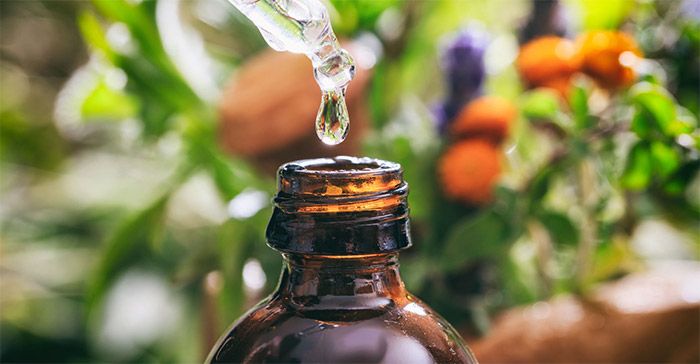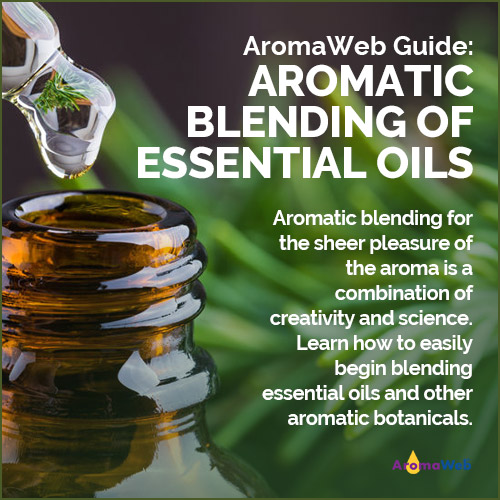Aromatic Blending of Essential Oils

How to Make Aromatic Essential Oil Blends
Aromatic blending for the sheer pleasure of the aroma is a combination of creativity and science. When using a blend created primarily for its fragrance, therapeutic benefit can also occur. The focus of the blend, however, is on the final aroma, not its therapeutic properties.
Safety precautions should be followed for any type of blending, including for aromatic blending. For instance, you would still want to be extremely careful when using Bergamot because of its phototoxic properties and still avoid using all hazardous oils and all oils that are contraindicated for conditions that you have.

Traditional perfumers that work for the famous fragrance houses study for years to master the art and science of perfumery blending. The perfumer’s standard repertoire consists of essential oils but also of synthesized chemicals that mimic the constituents (chemicals) of essential oils and other natural ingredients. Perfumers use synthesized chemicals and chemicals extracted from essential oils because they are often cheaper than using pure essential oils and because the chemicals are standardized and will be more consistent in aroma. If you can find a copy, The Science and Art of Perfumery by Edward Sagarin (copyright 1945) is a fascinating book that provides insight into the history and science of perfumery.
In aromatherapy blending, only natural ingredients such as essential oils, absolutes, CO2s, grain alcohol, carrier oils, herbs and water are used. Because commercial fragrances typically contain synthetic isolates, you shouldn't have high expectations for perfectly duplicating your favorite commercial fragrances.
Essential Oil Blending Basics
Essential oils can be categorized into broad groups based on their aromas. An example categorical system is as follows:
- Floral
Examples: Lavender, Neroli, Jasmine - Woody
Examples: Pine, Cedar - Earthy
Examples: Vetiver, Patchouli - Herbaceous
Examples: Marjoram, Basil - Minty
Examples: Peppermint, Spearmint - Medicinal/Camphorous
Examples: Eucalyptus, Cajuput, Tea Tree - Spicy
Examples: Nutmeg, Clove, Cinnamon - Citrus
Examples: Orange, Lemon, Lime
For a much more detailed list of 100 essential oils categorized into 18 groups, see AromaWeb's Guide to Essential Oil Aromatic Classifications.
Oils in the same category generally blend well together. I hesitate specifying that particular categories blend well with other specific categories because it can limit your creativity and experimentation. Additionally, there are always exceptions. But to get you started, below are some categories that generally blend well together:
- Florals blend well with spicy, citrusy and woodsy oils.
- Woody oils generally blend well with all categories.
- Spicy oils blend well with florals and citrus oils. Be careful not to overpower the blend with the spicy oils.
- Minty oils blend well with citrus, woodsy, herbaceous and earthy oils.
Harmonizing Your Essential Oil Blend
Have you ever noticed that a fragrance smells differently after several hours than when you first apply it? Some essential oils and their constituents evaporate more quickly than others. As the oils in a blend evaporate, the aroma will change to reflect the aroma of the aromatic molecules that remain.
Using the analogy of a musical scale, oils that evaporate the quickest, usually within 1-2 hours, are called “top notes.” Oils that evaporate with 2-4 hours are considered “middle notes.” Oils that take the longest time to evaporate are referred to as “base notes.” Some base notes can take several days to evaporate! Edward Sagarin credits Septimus Piesse with this analogy that has been used by many perfumers:
“Another contribution to the field of odor classification was made by the famous perfumer and perfume historian, Septimus Piesse. This unique figure in the history of the science created what he called an “odophone.” the odors were like sounds, he pointed out, and a scale could be created going from the first or lowest note, the heavy smell to the last or highest note, the sharp smell. In between there was an ascending ladder. Each odor note corresponded to a key on his odophone, and in the creation of a happy mixture of many different odors, which we call a “bouquet” and which every finished perfume must be, the creator seeks not only to hit the right notes, but to strike those notes which go with one another. His perfume must not be out of tune.” [Edward Sagarin, The Science and Art of Perfumery (New York, NY: McGraw-Hill, 1945), 145.]
List of Essential Oils Based Upon Their Aromatic Note Classification:
Blending does not have hard and fast rules that must be followed to create that wonderful blend that you’ll love for a lifetime. The lack of limits and restrictions is what makes perfumery an art form. Having said that, a few tips will help get you off to a fine start:
Essential Oil Blending Tips
- Safety first. Safety precautions should be followed for any type of blending, including for aromatic blending. Avoid essential oils that are known skin irritants and be sure to follow the safety guidelines for each essential oil that you are considering incorporating into your blend.
- When creating a new blend, start out small with a total number of drops of either 5, 10, 20 or 25 drops. 25 drops should be the most that you start with. By starting small, you waste less oil in your blending experiments.
- To blend and store your beautiful creations, 2ml amber “shortie” bottles are an inexpensive choice when blending small quantities. They are available from glass bottle packaging suppliers and aromatherapy vendors. Larger bottles in array of glass and packaging options are also available.
- Start creating your blend by only using essential oils, absolutes or CO2s. After you have designed the blend, then you can dilute it by adding carrier oils, etc. If you hate the blend you created, you have then not wasted any carrier oils.
- Keep a notebook that lists each oil that you used with the number of drops used for each oil. When the creative juices flow, it is easy to get carried away and later forget the exact recipe for your blend; one drop too much or too little of even one oil can drastically change the aroma of your blend. When you find that perfect blend, you want to be able to reduplicate it, and it’s near impossible if you didn't take notes! If you are especially ambitious, it’s also a wise idea to note the vendor name of the oil that you used as the aroma and quality of oils do vary between vendors (even with the same vendor, the aroma of oils can vary from batch to batch, due to crop fluctuations and resourcing).
- Be sure to label your blends clearly. If you don’t have enough room to specify exactly what your blend is, label it with a number that corresponds to a number in your notebook.
- Start off your blending experiments by creating blends that are made up in the following ratio (you do not have to be exact – this is just a guideline to get you started): 30% of the oils are top notes, 50% are middle notes, and 20% are base notes. See the chart above to find out what oils belong to each category.
- Some oils are much stronger than others, especially the absolutes and CO2s. Study oils you wish to use in a given blend and observe the oils that have the strongest aromas. Unless you want those oils to dominate the blend, you will want to use dramatically less of the stronger oils in your blend.
- To learn more about the strength of oils, it is useful to experiment. Begin by adding one drop of a selected essential oil to 4 drops carrier oil. This will result in a 20% dilution. Smell it and study the aroma. To obtain a 10% dilution, add 5 more drops of carrier oil. Smell it, study the aroma again, then repeat as desired. This can help educate you on the characteristics and strengths of each essential oil at various dilution ratios.
- After creating your blend, allow it to sit for a few days before deciding if you love or hate it. The constituents (natural chemicals) contained within the oils will get cozy with each other and the aroma can change, usually rounding out a bit.
Essential Oil Recipes
Solid Perfume Recipe
See AromaWeb's Natural Solid Perfume Recipe located in the Recipes section.
Carrier Oil Base Perfume Recipe
- 6 drops of your perfume blend
- 1 tablespoon Jojoba (other carrier oils may be substituted, but stable carrier oils with longer shelf lives are recommended)
Directions: Blend all oils together well and store in an airtight dark-colored glass container. Dab a drop onto your pulse points. As with any blends that you use, you must check all safety data for the oils in your blend and do a skin patch test prior to using. Avoid all essential oils that are skin irritants.
Body Splash Recipe
- 3 teaspoons High Proof Vodka
- 3 teaspoons Distilled Water
- 10 drops of your perfume blend
- Solubilizer (follow manufacturer's instructions for amount needed)
Directions: Blend all ingredients well and store in an airtight 1 ounce dark-colored glass container fine-mist sprayer bottle. As with any blends that you use, you must check all safety data for the oils in your blend and do a skin patch test prior to using. Avoid all essential oils that are skin irritants. This makes only a one-ounce quantity so that you can “try” your body splash to see if you like it before making a larger quantity.
Air Freshener Recipe
An air freshener can be created that serves purely an aromatic or a therapeutic purpose. See the Air Freshener recipe within the Recipe Box area for a base recipe that you can use for your custom blend.
Aromatherapy Blending Guide:
- Part 1: Introduction to Blending Essential Oils
- Part 2: Aromatic Blending of Essential Oils (You Are On This Page Now)
- Part 3: Formulating Masculine/Earthy Aromatherapy Blends
- Part 4: Therapeutic Blending of Essential Oils
- Part 5: Working With and Blending Thick Aromatic Oils
- Part 6: How to Substitute Essential Oils in Aromatherapy Recipes and Blends
- Part 7: Safely Diluted Essential Oil Blends May Seem Weak At First
See Also:
